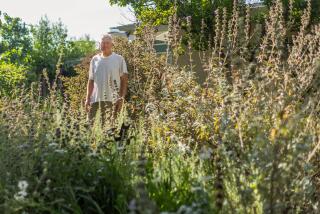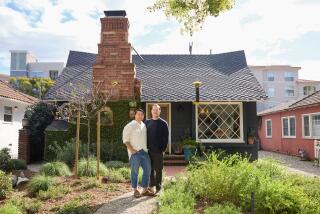He’s Bursting With a Bounty of Boysenberries
- Share via
I have to admire the restraint of neighbors who walk by our boysenberries--so fat and ripe they are about to burst--and don’t pick one. We grow them on a picket fence in the frontyard and, though the fence is set back from the sidewalk several feet, they are within reach.
We’ve been picking a bowlful every morning for several weeks, and I can say, through berry-stained lips, that boysenberries are one of those fruits and vegetables that are so much better home-grown.
You can pick them just the way you like--a little tart or, as I do, a little later when they’re juicy and sweet and warmed by the sun. Even at farmers markets, you can’t find them at this stage.
I wasn’t sure planting them along a 3-foot-tall picket fence would work since taller trellises are usually recommended, but the one plant we put in several winters ago produces plenty of berries.
Along the fence it takes up virtually no garden space, and the berries are easy to find and pick, which is why I’m amazed so little pilfering has gone on. Even the birds leave them alone, perhaps because the fence is so low.
It may be the ideal spot. The flowers--and then the ripening fruit, which turns from green to red to shiny black--are nearly as decorative as wild roses, to which they are related.
The trailing blackberries we grow in the West, including the variety called a boysenberry, are different from most fruits in that they take two years to produce a crop. The first year, long canes grow (to 12 feet or more), and I just let these sprawl on the ground. The second year, these canes flower and fruit.
As soon as the fruiting canes finish up, they are cut to the ground because they will not fruit again. The canes that have been growing along the ground are then lifted up onto the fence and woven between the pickets.
When we go out into the garden to prune the old blackberry canes and lift up the new--which we are about to do--we go heavily armored with gauntlet-like gloves because trailing blackberries are very thorny. We also keep a sharp eye out for the inevitable sprouts that spring from the roots. These pop up all over the garden and would turn it into a bramble given the chance.
Even the tips of growing canes will root into the ground. Blackberries are native to California and tend to act like they own the place, so they need constant watching. But what a small price to pay for those delicious berries.
Pulp Fiction
Home-grown is not always better. Artichokes are another decorative frontyard crop at our house, but they haven’t been nearly as good as the berries.
This was brought home after a trip north that included a stop at one of the roadside stands in Castroville, north of Monterey. The fat flower buds from the “Artichoke Capital of the World” were heavy and meaty, with lots of flesh to scrape off with your teeth, and a big heart.
Our home-grown are stringy and lean, though the hearts are quite good. Monterey County farm advisor Bill Chaney suggested some reasons ours are so lean and theirs so beefy.
Climate is one obvious difference. In Castroville, the nights are chilly and foggy, and it’s a tingling kind of fog that we seldom get, even near the beach where I garden. This allows the buds to develop slowly so each petal accumulates a lot of pulpy meat.
In breezy Castroville, most of the artichokes are grown by old Italian families and they closely guard their varieties, propagating them year after year from divisions. Though they call them ‘Globe’ artichokes, Chaney says they are different from the ‘Globe’ sold at nurseries. He suggested planting as many different kinds of artichokes as one can find, then save the best and propagate your own from divisions.
In our case, this hasn’t worked. We tried one sold as ‘Globe’ and it was disappointing. So is the new seed-grown strain named ‘Imperial Star.’ Despite promises of pulpy petals, that turned out to be fiction. It made a lot of edible buds, on a somewhat smaller plant, but there simply wasn’t enough meat to make it worth the effort. ‘Violetto,’ with its purple buds, was striking but like eating a dried thistle. It also got huge--a 5-foot plant with vicious spiked leaves.
Consolation Prize
After trying a few chokes from each of these varieties, we gave up on the rest and let them flower, drying the pretty, purple, thistle-like flowers for the house--our consolation prize.
One thing Chaney mentioned might help. He said the Castroville artichokes are never allowed to dry out--the soil is always moist (but never soggy wet). Since ours grow in the front yard, which is full of drought-resistant herbs and perennials, we perhaps have not given the ‘chokes enough water.
Our ‘Imperial Star’ is just finishing up now, and this is the time to cut artichoke plants completely to the ground and them give them a little fertilizer. They’ll resprout, grow through the summer and produce buds again in fall, but maybe this time we’ll give them a little more water and see if we can’t fatten up this California favorite.






